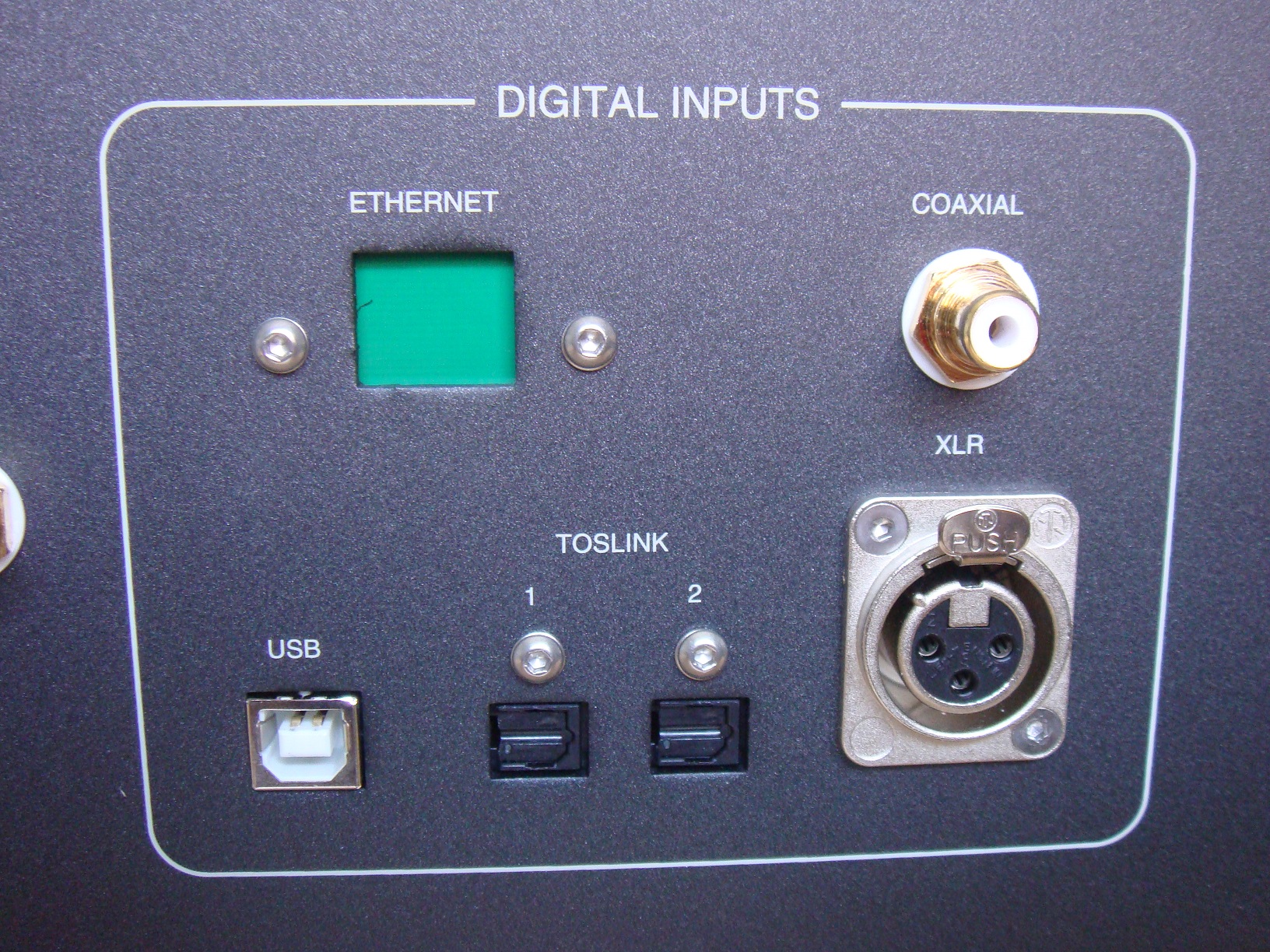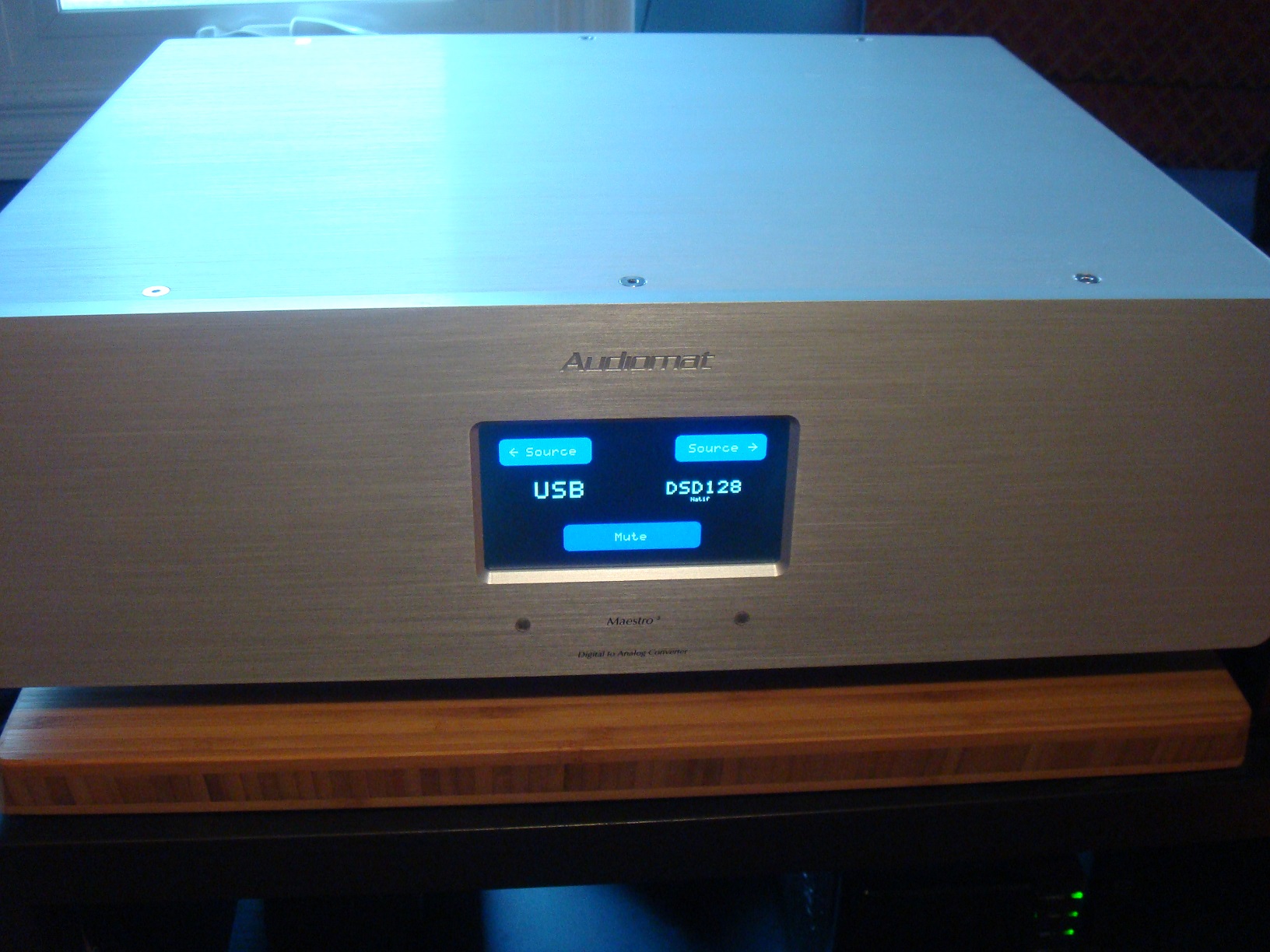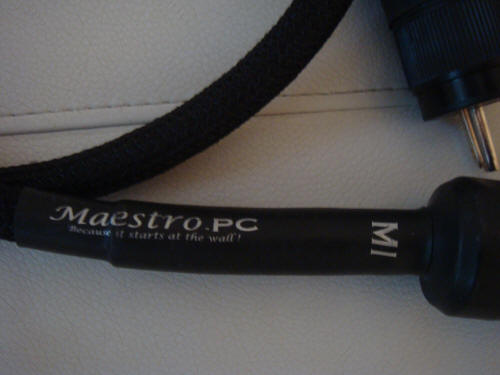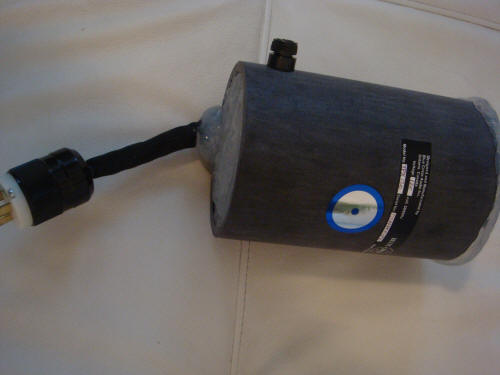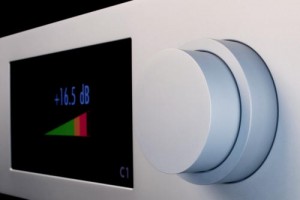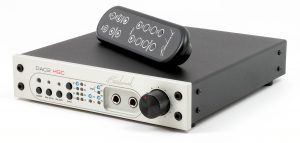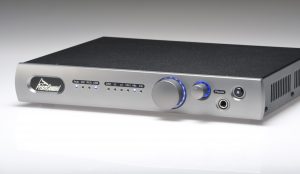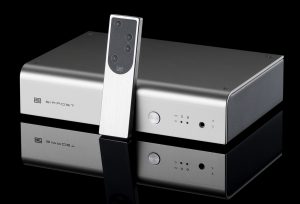Based in France, Audiomat was started in 1986 by brothers Denis and Norbert Clarisse. Denis designs the equipment and Norbert manages the company. Their first product was a 50kg 20 watt OTL amp with 16 6AS7 triodes, two stages, no feedback, and run in pure class A. Several integrated amps and DACs followed which received a good deal of positive press, especially in Europe. Besides the Maestro 3 DAC, the subject of today’s review, Audiomat currently offers several integrated amps, two phono stages, a line preamp, a power amp, three DACs and a CD transport.
Audiomat is not exactly a house-hold name in North America but its products are well worth seeking. It’s a tiny company that builds all its products by hand in small numbers and you won’t see new and improved models every six months. Audiomat is in many ways the epitome of a cottage industry.
The Maestro 3 DAC sits behind Audiomat’s statement DAC, the Maestro 3 Reference.
Audiomat was a little short on specific technical details other than the Maestro 3 uses an unspecified 32-bit AKM DAC. My guess is one of AKM’s new 32-bit Premium DACs, which are capable of decoding PCM up to 32-bit/384 kHz, and DSD up to double rate i.e. 128x/5.6448MHz. This was a surprise as Audiomat has stuck with Burr-Brown chips with all their previous DACs. Norbert and Denis are not what I would call audio fashionistas and are therefore not prone to jumping on the latest dac-chip-of-the-month bandwagon and instead tend to focus on implementation and spend months if not years carefully tweaking a design before releasing it. So the Brothers Clarisse must have heard something special with the AKM. As with all Audiomat DACs the Maestro 3 features a robust power supply, far more extensive than I normally see with digital gear these days, a discrete analogue output stage and plenty of capacitance—I stopped counting after 300,000 uF when poking around under the hood. Note the physical separation of digital and analogue circuits. Also the power supply transformers are housed in a separate enclosure and connected to the DAC via a shielded detachable umbilical.
The Maestro 3 will accept Coax S/PDIF, XLR Balanced (AES/EBU), Toslink, and USB… plus Ethernet via an optional proprietary plug-in module. The USB input, courtesy of Amanero, can handle PCM up to 32-bit/384kHz and DSD up to double rate DSD (128x/5.6448MHz) while the Toslink, Coax, and XLR inputs are limited to 24/192. Outputs include single-ended RCAs and balanced XLRs and Coax S/PDIF (limited to 24/192). The optional Ethernet module effectively transforms the Maestro 3 DAC into a network player; this feature was unfortunately unavailable for this review.
The front panel sports a nice blue touch panel display that shows the incoming file's bit sample rates and source. An optional remote is also available. You can also dim or turn off the display, mute output, invert polarity, allow native DSD or resample DSD to PCM, as well as choose four filter settings. The default which Audiomat recommends is the Short Delay/Sharp Roll Off setting. I preferred Short Delay/Slow Roll Off. However, the settings are so subtle I wouldn’t get too worked up on which is best. I simply thought the latter setting a tad smoother and a little more open, but I’m really splitting hairs here.
The DAC enclosure measures 445mm x 345mm x 130mm and weighs in at 11kg. The power enclosure containing the two 100VA trannies measures 230mm x 110mm x 60mm and weighs 3kg. Overall the fit and finish of the Maestro 3 was typical Audiomat—understated elegance. The DAC sits on three sharp cones so beware of what you place it on; mine sat on a nice Ikea bamboo cutting board. I placed the power enclosure on another bamboo cutting board as far away from the DAC as possible on separate shelf. I used the Maestro 3 with my tweaked (I have just enough of Windows 8 enabled to keep the PC running) Asus i7 laptop. As per the manual I downloaded and installed the required Amanero Windows drivers. I used J River Media Center 20 or JPLAY 6 for playback. However, for whatever reason I obtained optimum sound by using JPLAY’s new JPLAY Streamer renderer and JRMC 20’s DLNA as server with BubbleUPnP on my Google Nexus 7 as control point. Music files were served by a Sonology DS214 NAS which was connected to network switch and laptop via two 1m lengths of Sablon Audio Panatela LAN. Ethernet cable from switch to router was 60’ of generic CAT6. Light Harmonic’s LightSpeed USB cable connected laptop to Maestro 3 which in turn was linked to my Audiomat Opera Reference with Sablon Audio Panatela interconnects. Speakers were JM Reynaud Evolution 3 and REL Q108 subs. All power and speaker cabling was Sablon Audio.
In my ten plus years of reviewing audio equipment I have found that some components instantly come across with a more distinct voice than others do or perhaps I should say they simply stand out in a vast field of like-minded products. The Audiomat Opera Reference integrated amp pretty much did all that when I first fired it up years ago and now the same is true with the Maestro 3. Add in that both components strike me as offering a near perfect ideal of how I think audio equipment should present recorded music. I am sure there are others, likely more expensive, that might be superior but at these price points, they are my references. The Maestro 3 DAC pretty much grabbed my attention completely as soon as music poured forth from my speakers.
Not only endowed with a beguiling sense of fluidity and drive allied to a rich vibrant tonal balance you could cut with a knife, the Maestro 3 also delivered an amazing level of detail. Things like drum sticks hitting cymbals, the staccato whack of flamenco guitar, the deep resonant growl of double bass and the sting of a Gibson Les Paul cranked up to 11 was conveyed with an eerie exactness that many DAC’s miss completely. The Maestro 3 was able to extract vast amounts of musical information and present it in a precise manner but while also sounding completely natural and without negatively effecting the tonal or textural balance. All too often, digital sacrifices some of the tonal character of music on the altar of detail and resolution. The Maestro 3 proves that it does not have to be so. And that's pretty frickin’cool in my experience.
Everything I played through the Maestro 3 sounded awesome; Mahler’s enormously complex oeuvre, the delicate shadings of Debussy’s piano Preludes, the raucous roar of Sonic Youth’s Dirty, the demented homicidal rantings of Nick Cave’s fabulous Murder Ballads, Thelonious Monk’s spaces-between-the-notes brilliance of Live at the It Club and the suave and debonair vibe of Roxy Music’s Avalon. Recordings I've heard hundreds of times came across with a clean, delicate clarity and textural fidelity that was stunning. Or put another way, music sounded like music rather than an impression of music.
Getting more into the Maestro 3’s sound, the Maestro 3 DAC came across even keeled across the frequency spectrum including a deep, full-bodied, well-articulated bass response. The top end was well extended yet silky smooth and airy. More importantly there was a textural fidelity and midrange richness that I find wanting in pretty much all of the current rage of bells and whistles DACs these days. I attribute that to Audiomat’s fanatical approach to power supply and analogue out stage design. Many audio firms skimp these two areas on to keep costs down. A DAC capable of DSD or 32/384 PCM playback is pointless regardless of price if it does not move the human soul. Yet it’s the power supply and output stage that mostly determine what we hear and not what DAC chip is used or what sample rates or formats it can handle.
Every note played seemed perfection. It’s not just what I heard in a piece of music but also the why. The interpretive nuances and stylistic differences and violin tone of Arthur Grumiaux and James Ehnes on their respective recordings of Bach’s Violin Sonatas and Partitas was startling in its clarity. Just flipping back and forth between the albums was shocking in just how different these two recordings were. And these are recordings I know intimately and yet the shock and surprise I noted when comparing the two on the Maestro 3 was unlike anything I’ve heard before even with Audiomat’s Tempo 2.6 and the considerably more expensive Calyx Femto I reviewed some time ago.
The Maestro 3 DAC was never edgy or unnaturally bright even though its level of resolution was outstanding. Bad recordings still sounded like hammered shit but didn’t irritate me. I could get past the sonic defects and zero in the music with little effort. Resolution is great but any component that makes half your music library unlistenable is broken in my opinion. Regardless of source material, music consistently came across compelling and alive with the Maestro 3.
I listened to all manner of formats from 16/44.1 up to DSD. I also did a good deal of listening via Tidal’s lossless streaming service, which I continue to use beyond the free trial period. For $20 a month, I am a mouse click or two away from millions of tunes the vast majority of which are FLAC. Tidal still needs a good deal of work however. The search engine is pretty much useless and requires a great deal of creativity and patience to find what you are looking for. A perfect example of an online music search engine is that provided by Naxos on their ClassicsOnline HD service. Furthermore I have found at least two albums in my limited time with Tidal that either were mislabelled or were completely different pieces of music. For example, I picked what I thought was Zemlinsky’s Lyric Symphony conducted by Christoph Eschenbach but much to my surprise was actually a recording of Bruckner’s 1st Symphony! While listening to Gerard Poulet and Noel Lee performing Faure’s Violin Sonatas, music I know well, I realized the tracks were mixed up. What was supposed to be the opening Allegro of Sonata No. 1 in fact was the Finale of Sonata No. 2. Yikes! Obviously some bugs still to ferret out and Jay Z needs to kick a few butts but I love the concept. I’ve been on a reggae binge of late and Tidal was there to help. I delved into reggae/dub greats such as Horace Andy, The Upsetters, King Tubby, Max Romeo and Black Uhuru. Reggae/dub is all about the groove and chest-crumbling bass. With the Maestro 3 I was fully able to explore my inner Rastaman with its infectious way of capturing the propulsive rhythms and window rattling bass throb of dub. And while the bass was deep and powerful it was articulate and exceedingly tactile. I could feel the shape of the notes.
DSD playback was exemplary. Generally speaking, there’s a three-dimensional holographic quality I find with DSD along with a wonderfully smooth and rich character. All this I heard in spades with the Maestro 3. I even tried resampling on-the-fly all my PCM material to DSD (via JRiver) and DSD to PCM which I thought was interesting. I cannot say for certain if one format is superior to the other as there are far too many variables involved. I’ll just leave it at DSD simply sounds different. For me, the music itself is far more important than the format. Often I pretty much ignored the sampling rate indicator on the Maestro’s display and avoided any re-sampling or format conversion.
Although I used the Maestro 3 with my file based system for the bulk of my review time I did hook it up via S/PDIF to my CEC TL51 transport and an old Rotel RCD-971 CD player. I heard the same traits as noted elsewhere albeit to a higher degree with the TL51 than with the Rotel. And as I reported in my review of CEC’s TL3N some CD’s still sound more natural and musical than the ripped versions for reasons unknown to me although I suspect it has to do with pressing quality. Most of my older discs, especially Denon ones sound better than the ripped files. Having said that, I’ve pretty much retired my CD playback gear as I find file based playback, with the exception of the above, more enjoyable and way more flexible. It wasn’t always this way and took a couple years of trial and error but going back to CD just ain’t happening for me. Whether used in a more traditional CD playback system or file based, the Maestro 3 is an exceptional DAC.
How did the Maestro 3 compare to my Tempo 2.6? The first thing I noticed after connecting the Tempo 2.6 up and hitting play is the overall soundscape shrank and the top end shelved down. Dynamics and textural complexity also took a step back. The Tempo 2.6 also came across slightly veiled and diffuse in comparison. This was a bit of a surprise to me as I would never in a million years describe the Tempo as sounding as such. In fact the Tempo up to now has been superior to pretty much everything else I have heard in this regard. While I still enjoy my Tempo 2.6 DAC, the Maestro delivered a bigger, richer, more complex and ultimately a more natural and engaging musical presentation.
I can’t see how anyone would not appreciate the Maestro’s resolute yet wonderfully smooth presentation. By smooth I mean what the Maestro 3 is completely devoid of that digital sound that annoys so many audiophiles. So much of digital reproduction can sound hard-edged and two-dimensional. While this is becoming less the norm, the degree to which the Maestro delivered a non-digital sound was impressive to say the least. Suffice it to say I barely listened to my vinyl rig during the review period.
There was a wonderful sense of life and vibrancy with the Maestro 3 that brought with it an intoxicating degree of excitement and immediacy. If the Maestro 3 were a narcotic I’d be dire need of an intervention. As is was I had a difficult enough time staying away from my system to tend of other chores much to the chagrin of my wife. Even the dog missed out on a couple of walks. Shame on me I know but I have never experienced digital that was inviting and natural as provided by the Maestro 3.
Pure, elegant, vibrant, colorful, compelling and natural were some of the words that immediately came to mind when I first fired up the Maestro 3 prior to my usual 2-3 weeks of run-in time before making any critical assessment. As it happens, they are the same words that came to mind at the end of the review period. It was as if anything extraneous or smacking of the artificial had been stripped away. This was evident regardless of format or sample/bit rate. In fact, the Maestro 3 liberated all manner of music sources and pretty much banished any thoughts of sample rates or formats, DAC chips altogether and simply allowed me to enjoy music for what it was. Too many audiophiles get obsessed over the latest chip or specs, sample rates etc. Find something that serves the music first, I say.
To say that I was impressed with the Audiomat Maestro 3 is an understatement. Its ability to turn digital music reproduction into a totally engaging immersive musical experience was stunning. Offering up to 32/384 PCM and 2x DSD playback plus the option of transforming it into a network player, the Maestro 3 has got it all as far as I am concerned so much so I purchased my review loaner. It’s just too damn good to live without. Warmly recommended.
Distributor (Americas, Australia and parts of Asia): www.mutine.com
Price: Approx. CDN$8,990 depending on current exchange rates





